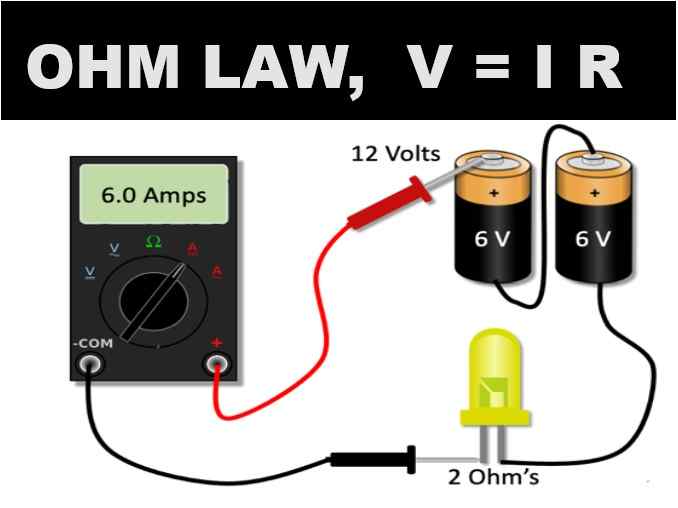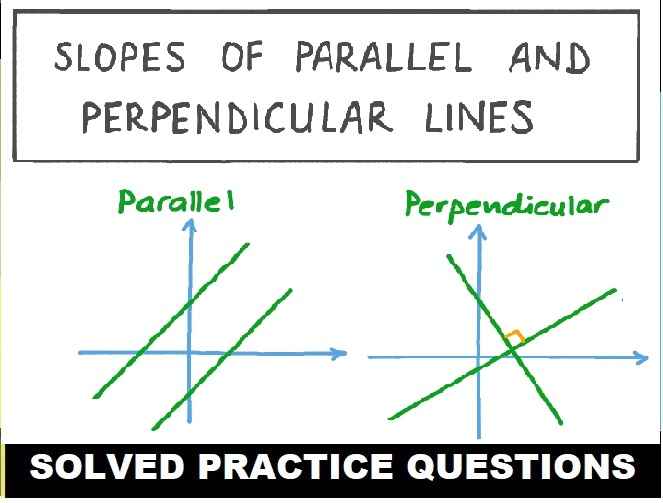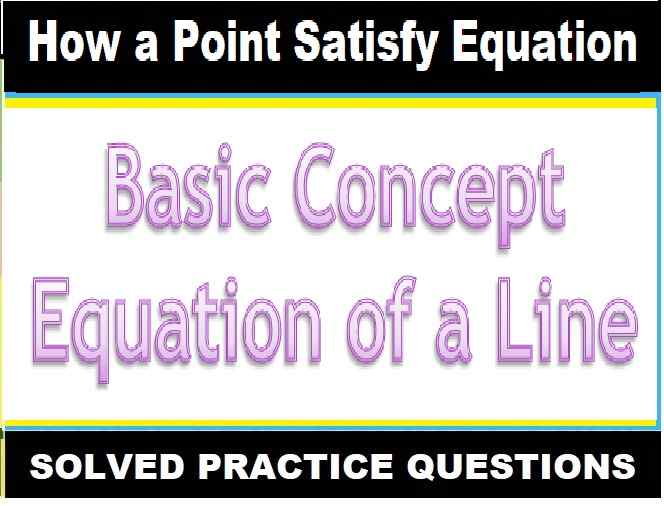MCQs Amines Organic Compounds containing Nitrogen for ISC Class 12 Questions with Answers. These MCQ / Objective Type Questions is based on latest reduced syllabus according 2021-22 session on bifurcated pattern. Main motto of MCQ Type Question is cracking the next upcoming Sem-2 exam of council. Visit official website CISCE for detail information about ISC Class-12 Chemistry
Amines Organic Compounds containing Nitrogen for ISC Class 12 MCQs Questions with Answers
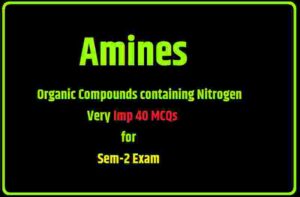
| Board | ISC |
| Class | 12th (XII) |
| Subject | Chemistry |
| Chapter | Organic Compounds containing Nitrogen |
| Syllabus | on bifurcated syllabus (after reduction) |
| Session | 2021-22 |
| Bifurcated | Sem-2 |
| Topic | MCQs / Objective Type Question |
MCQs Amines Organic Compounds containing Nitrogen for ISC Class 12 Questions with Answers
Question 1: Identify ‘Z’ in the sequence?
![]()
(a) C6H5CN
(b) C6H5CONH2
(c) C6H5COOH
(d) C6H5CH2NH2
Answer: (c) C6H5COOH
Question 2: Which of the following from isocyanide on reaction with CHCl and KOH?
(a) C6H5NHCH3
(b) CH3C6H4NH2
(c) C6H5NHC4H9.
(d) C6H5N (C2H5)2
Answer: (b) CH3C6H4NH2
Question 3: The strongest base among the following is?

Answer: (c)
Question 4: Which of the following is the strongest base?

Answer: (d)
Question 5: Find the compound which is more basic than aniline
(a) Diphenylamine
(b) Triphenylamine
(c) Benzylamine
(d) p-Nitroaniline
Answer: (c) Benzylamine
Question 6: Which of the following can exist as zwitter ion?
(a) p-Aminoacetophenone
(b) Sulphanilic acid
(c) p-Nitroaminobenzene
(d) p-Methoxyphenol
Answer: (b) Sulphanilic acid
Question 7: Reduction of aromatic nitro-compounds using Sn and HCl gives
(a) aromatic primary amines
(b) aromatic secondary amines
(c) aromatic tertiary amines
(d) aromatic amides
Answer: (a) aromatic primary amines
Question 8: Acetamide can be converted to methenamine by which of the following reactions?
(a) Stephen’s reaction
(b) Hoffmann bromamide reaction
(c) Carbylamine reaction
(d) Gabriel phthalimide synthesis
Answer: (b) Hoffmann bromamide reaction
Question 9 : An aldehyde on reaction with primary amine forms
(a) ketone
(b) Schiff’s base
(c) aromatic acid
(d) carboxylic acid
Answer: (b) Schiff’s base
Question 10: Arrange the following compounds in increasing order of basicity:
CH3NH2, (CH3)2 NH, NH3, C6H5NH2
(a) C6H5NH2 < NH3 < (CH3)2NH < CH3NH2
(b) CH3NH2 < (CH3)2NH < NH3 < C6H5NH2
(c) C6H5NH2 <NH3 < CH3NH2<(CH3)2NH
(d) (CH3)2NH < CH3NH2 <NH3 < C6H5NH2
Answer: (c) C6H5NH2 <NH3 < CH3NH2<(CH3)2NH
Question 11: Which of the following species are involved in the carbvlamine test?
(i) RNC
(ii) CHCl3
(iii) COCl2
(iv) NaNO2 + HCl
(a) (i) and (iv)
(b) (i) and (ii)
(c) (ii) and (iv)
(d) (ii) and (iii)
Answer: (b) (i) and (ii)
Question 12: Benzene forms Nitrobenzene on reaction with conc. HNO3/H2SO4, in the reaction HNO3 acts as a
(a) catalyst
(b) reducing agent
(c) base
(d) acid
Answer: (c) base
Question 13: Which of the following compound will form secondary amine on reaction with LiAlH4?
(a) Methyl cyanide
(b) Methyl isocyanide
(c) Acetamide
(d) Nitroethane
Answer: (b) Methyl isocyanide
Question 14: Primary and secondary amines are distinguished by
(a) Br2/ROH
(b) HClO
(c) HNO2
(d) NH3
Answer: (c) HNO2
Question 15: Nitrogen atom of amino group is ………. hybridised.
(a) sp
(b) sp2
(c) sp3
(d) sp3d
Answer: (c) sp3
Question 16: Benzene-diazonium chloride on reaction with phenol in weakly basic medium gives
(a) Diphenyl ether
(b) p-hydroxyazobenzene
(c) Chlorobenzene
(d) Benzene
Answer: (b) p-hydroxyazobenzene
Question 17: Which one of the following does not contain the -COOH group?
(a) Picric acid
(b) Aspirin
(c) Benzoic acid
(d) Ethanoic acid
Answer: (a) Picric acid
Question 18: C3H8N cannot represent
(a) 1° ammine
(b) 2° ammine
(c) 3° ammine
(d) quartemary ammonium salt
Answer: (d) quartemary ammonium salt
Question 19: Secondary amines can be prepared by
(a) reduction of nitro compounds
(b) oxidation of N-substituted amides
(c) reduction of isonitriles
(d) reduction of nitriles
Answer: (c) reduction of isonitriles
Question 20: Which of the following amides will give ethylamine on reaction with sodium hypobromide?
(a) Butanamide
(b) Propanamide
(c) Acetamide
(d) Benzamide
Answer: (b) Propanamide
Question 21: Identify the correct IUPAC name
(a) (CH3CH2)2NCH3 = N-Ethyl-N-methylethanamine
(b) (CH3)3CNH2 = 2-methylpropan-2-amine
(c) CH3NHCH (CH3)2 = N-Methylpropan-2-amine
(d) (CH3)2CHNH2 = 2, 2-Dimethyl-N-propanamine
Answer: (a) (CH3CH2)2NCH3 = N-Ethyl-N-methylethanamine
Question 22: The most convenient method to prepare primary (i Amine) amine containing one carbon atom less is
(a) Gabriel phthalmidie synthesis
(b) Reductive amination of aldehydes
(c) Hofmann bromamide reaction
(d) Reduction of isonitriles
Answer: (c) Hofmann bromamide reaction
Question 23: The bad-smelling substance formed by the action of alcoholic caustic potash on chloroform and aniline is
(a) Phenyl Isocyanide
(b) Nitrobenzene
(c) Chloropicrin
(d) Acetylene
Answer: (a) Phenyl Isocyanide
Question 24: Which of the following does not react with Hinsberg reagent?
(a) Ethylamine
(b) (CH3)2NH
(c) (CH3)3N
(d) Propan-2-amine
Answer: (c) (CH3)3N
Question 25:
![]()
above sequence, Z is
(a) Cyanoethane
(b) Ethanamide
(c) Methanamine
(d) Ethanamine
Answer: (d) Ethanamine
Question 26: Reduction of CH3CH2NC with hydrogen in presence of Ni or Pt as catalvst gives
(a) CH3CH2NH2
(b) CH3CH2NHCH3
(c) CH3CH2NHCH2CH3
(d) (CH3)3N
Answer: (b) CH3CH2NHCH3
Question 27: Which one of the following reducing agents is likely to be most effective in bringing about the following change?

(a) H2-Ni
(b) NaBH4
(c) LiAlH4 ether
(d) Na-AIcohol
Answer: (c) LiAlH4 ether
Question 28: What is the end product in the following sequence of reactions?

(a) Aniline
(b) Phenol
(c) Benzene
(d) Benzenediazxonium chloride
Answer: (a) Aniline
Question 29: Tertiary amines have lowest boiling points amongst isomeric amines because
(a) they have highest molecular mass
(b) they do not form hydrogen bonds
(c) they are more polar in nature
(d) they are most basic in nature
Answer: (b) they do not form hydrogen bonds
Question 30: C3H9N can have how many structural isomers?
(a) 2
(b) 3
(c) 4
(d) 5
Answer: (c) 4
Question 31: Products formed when Nitrobenzene reacts with HNO3/H2SO4 at 80-100°C
(a) 1, 4-Dinitrobenzene
(b) 1, 2, 4-Trinitrobenzene
(c) 1, 2-Dinitrobenzene
(d) 1, 3-Dinitrobenzene
Answer: (d) 1, 3-Dinitrobenzene
Question 32: Most basic species amongst the following is
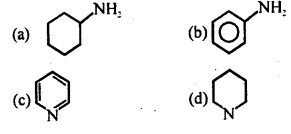
Answer: (d)
Question 33: When aniline is heated with cone. H2SO4 at 455-475 K, it forms
(a) aniline hydrogensulphate
(b) sulphanilic acid
(c) amino benzene sulphonic acid
(d) benzenesulphonic acid
Answer: (b) sulphanilic acid
Question 34: Which of the following compounds cannot be identified by carbylamine test?
(a) CH3CH2NH2
(b) (CH3)2CHNH2
(c) C6H5NH2
(d) C6H5NHC6H5
Answer: (d) C6H5NHC6H5
Question 35: What is obtained when benzoyl chloride reacts with aniline in the presence of sodium hydroxide?
(a) Benzoic acid
(b) Benzanilide
(c) Acetanilide
(d) Azobenzene
Answer: (b) Benzanilide
Question 36: Aniline first reacts with acetyl chloride producing compound A. A reacts with 𝐻𝑁O3/H2𝑆𝑂4 mixture and produces comp and B which hydrolyses to compound C. What is the identity of C?
(a) Acetanilide
(b) p-Nitroacetanilide
(c) p-Nitroaniline
(d) Sulphanilic acid.
Answer: (c) p-Nitroaniline
Question 37: Which is most basic?
(a) C6H5NH2
(b) (C6H5)2NH
(c) CH3NH2
(d) (CH3)2NH
Answer: (d) (CH3)2NH
Question 38: When excess of ethyl iodide is treated with ammonia, the product is
(a) ethylamine
(b) diethylamine
(c) triethylamine
(d) tetrathylammonium iodide
Answer: (d) tetrathylammonium iodide
Question 39: Amides may be converted into amines by a reaction named after
(a) Hofmann Bromide
(b) Claisen
(c) Perkin
(d) Kekule
Answer: (a) Hofmann Bromide
Question 40: The amine that does not react with acetyl chloride is
(a) CH3NH2
(b) (CH3)2NH
(c) (CH3)3 N
(d) none of these
Answer: (c) (CH3)3 N
–: End of MCQs Amines Organic Compounds containing Nitrogen :–
-: also visit :-
- ISC Sem-2 Question Bank Class-12
- Sem-2 ISC Specimen Paper for Class-12
- ISC Class-12 Textbook Solutions ,Syllabus, Solved Paper
- Previous Year Question Paper for ISC Class-12
Please share with your ISC friends if it is helpful
Thanks
